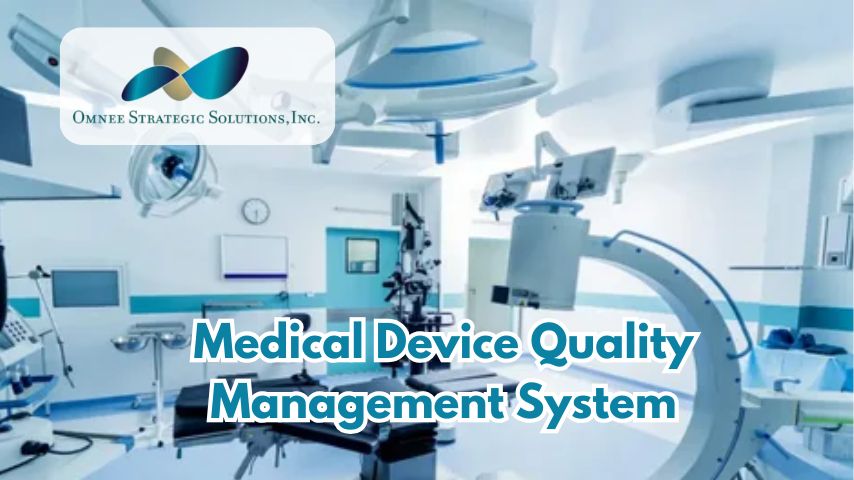In the fast-paced and highly regulated world of medical devices, maintaining a robust Medical Device Quality Management System (MDQMS) is essential for ensuring product safety, efficacy, and compliance with regulatory standards.However, organizations often face several challenges in implementing and sustaining such a system. This blog explores these challenges and offers practical strategies for overcoming them, emphasizing the role of Omnee Strategic Solutions in streamlining quality management processes.
Understanding the Medical Device Quality Management System
A Medical Device Quality Management System is a structured framework that helps organizations manage quality across the lifecycle of a medical device. It encompasses processes for design, manufacturing, distribution, and post-market surveillance, ensuring that products consistently meet quality standards and regulatory requirements. The goal is to enhance patient safety and device performance while minimizing risks.
Challenges in Maintaining a Medical Device Quality Management System
- Complex Regulatory Requirements
- The medical device industry is subject to stringent regulations from agencies such as the FDA (Food and Drug Administration) and EMA (European Medicines Agency). Understanding and navigating these requirements can be overwhelming, especially for smaller organizations or startups.
- Solution: Regular training and education on regulatory changes are crucial. Organizations should invest in compliance management software that tracks regulatory updates. Collaborating with experts like Omnee Strategic Solutions can provide the necessary guidance and support to ensure adherence to evolving regulations.
- Inadequate Documentation Practices
- Documentation is a cornerstone of an effective MDQMS. Poor documentation practices can lead to errors, miscommunication, and compliance issues. Many organizations struggle with maintaining comprehensive and up-to-date records.
- Solution: Implementing a centralized document control system can streamline documentation processes. This system should include templates, checklists, and automated reminders for reviews and updates. Regular audits of documentation practices can identify areas for improvement.
- Cultural Resistance to Change
- Quality management often requires changes in established processes and practices. Employees may resist adopting new systems or procedures, viewing them as unnecessary burdens rather than improvements.
- Solution: Fostering a quality culture within the organization is vital. Leaders should communicate the benefits of the MDQMS and involve employees in the implementation process. Training programs that emphasize the importance of quality and how it impacts patient safety can also facilitate acceptance.
- Integration of Quality Management Systems
- Integrating the MDQMS with other operational systems, such as manufacturing and supply chain management, can be challenging. Disparate systems may hinder effective data sharing and collaboration.
- Solution: Organizations should seek integrated quality management software that can connect with existing systems. This integration enables seamless data flow and provides a comprehensive view of quality metrics across the organization.
- Resource Constraints
- Limited resources, including budgetary restrictions and staffing shortages, can hinder the effective implementation and maintenance of a MDQMS. Smaller organizations, in particular, may struggle to allocate sufficient resources to quality management efforts.
- Solution: Prioritizing quality initiatives based on risk assessment can help organizations focus their resources where they are most needed. Additionally, partnering with consulting firms like Omnee Strategic Solutions can provide access to expertise and resources without the need for substantial investment in internal staff.
- Continuous Improvement and Monitoring
- A successful MDQMS requires ongoing monitoring and improvement. Many organizations fall into the trap of viewing quality management as a one-time effort rather than a continuous process.
- Solution: Establish key performance indicators (KPIs) to measure the effectiveness of the MDQMS. Regular reviews of these metrics can help identify areas for improvement and inform decision-making. Implementing a corrective and preventive action (CAPA) system can also facilitate continuous improvement.
- Technology Challenges
- The rapid advancement of technology poses both opportunities and challenges for quality management. While new tools can enhance efficiency and accuracy, they also require training and adaptation.
- Solution: Organizations should invest in training programs that ensure employees are proficient in using new technologies. Additionally, selecting user-friendly software solutions can ease the transition and minimize resistance to change.
Conclusion
Maintaining an effective Medical Device Quality Management System is a multifaceted challenge that requires careful planning, resources, and a commitment to continuous improvement. By addressing the challenges outlined above and leveraging the expertise of partners like Omnee Strategic Solutions, organizations can enhance their quality management practices and ensure compliance with regulatory standards. This proactive approach not only safeguards patient safety but also enhances the overall performance and reputation of medical device manufacturers.
By adopting best practices and fostering a culture of quality, organizations can turn challenges into opportunities for growth and improvement in the ever-evolving medical device landscape.





Comments